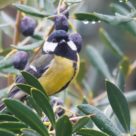We have tried and tested…
the Revellata ridge walking path in Calvi just for you
After November’s gloomy weather, we thought a breath of fresh air would do us some good…
Accompanied by officials from the Coastline Protection agency and the Corsican government, we strode along the paths of the Revellata ridge. In reality, the idea of this day trip wasn’t to trudge up to some place we had already taken you to, like the customs officers’ path for example, but rather into the unknown (at least for the moment!). Intrigued by exploring new places, we heard about a new path, opened not all that long ago by the Coastline Protection agency, as well as many heritage discoveries made during maintenance work and also made by the coastguards whilst on watch.
What we learnt…
Just like us today, when you next visit this spot, you will have the pleasure of seeing low drystone walls popping up as if by magic from the dense scrubland, evidence of the last trace of human activity in Revellata. You will also spot the stone canalette (small channels) which drain the rainwater and…the aghja (threshing floor) in exceptionally well-preserved condition!
Strolling along the Alga valley path, we stopped to take a closer look at a geological curiosity known as an “Eolianite”*. In other words, rocks formed by the gradual fossilisation of sand, which is an incredibly impressive sight!
Then, we were shown the changes already made (and future changes to be made) to the lay of the land, which is sure to delight walkers who decide to head out on this adventure. In the future, a circulation plan will be marked out so that visitors can discover the site whilst respecting the area, the new developments and other visitors. Everyone will have their own dedicated space and specific track to promote a harmonious cohabitation between strollers and sports enthusiasts.
There’s the sun, sky, sea and…posidonia!
They also explained to us the importance of leaving what we call “dead seaweed” washed up on the shore. Just like you, we wondered why we couldn’t remove it, so we could enjoy the flawless white sand underneath!
Well, guess what? Although we often tend to wrongly label these plants as “seaweed”, they are actually posidonia. Posidonia is essential as it has the important function of naturally filtering seawater, ridding it of its bacteria (even the bacteria us humans produce!).
Furthermore, its presence on our beaches is a sign of its cleanliness, and it also helps slow down coastal erosion. In short, the more posidonia on our beaches, the happier we should be!
Oh yes, we forgot about the bins!
We were surprised to not find any bins anywhere on site, even though it was immaculate, so we took it upon ourselves to ask why. It was to our great surprise that we were told that this was an intentional decision!
When seeing how surprised we were, they explained their reasonings behind this decision: “No bins equals no overspilling rubbish! By having no bins, it means people are more likely to take their rubbish home with them and sort it into the appropriate bins. Here, there are often strong winds which would blow all of the rubbish about. Plus, it is not easily accessible for rubbish collection.” All of a sudden, it seemed like the obvious solution and way more logical!
Finally, what we took away from this day, besides everything that we learnt, was a wonderful moment shared with these environmental enthusiasts. Captivated by the landscapes they showed us, they persuaded us of the benefits of protecting this area, whilst enjoying what it has to offer as much as possible.





